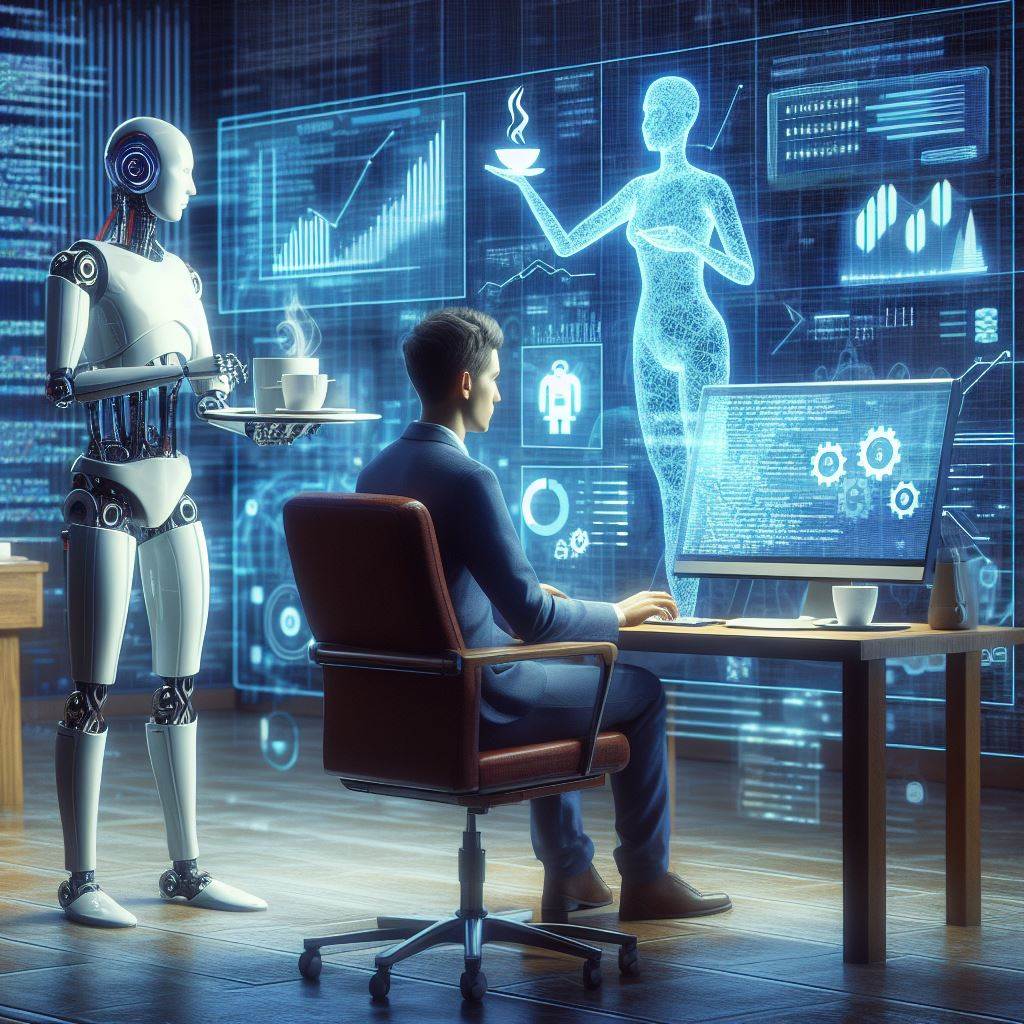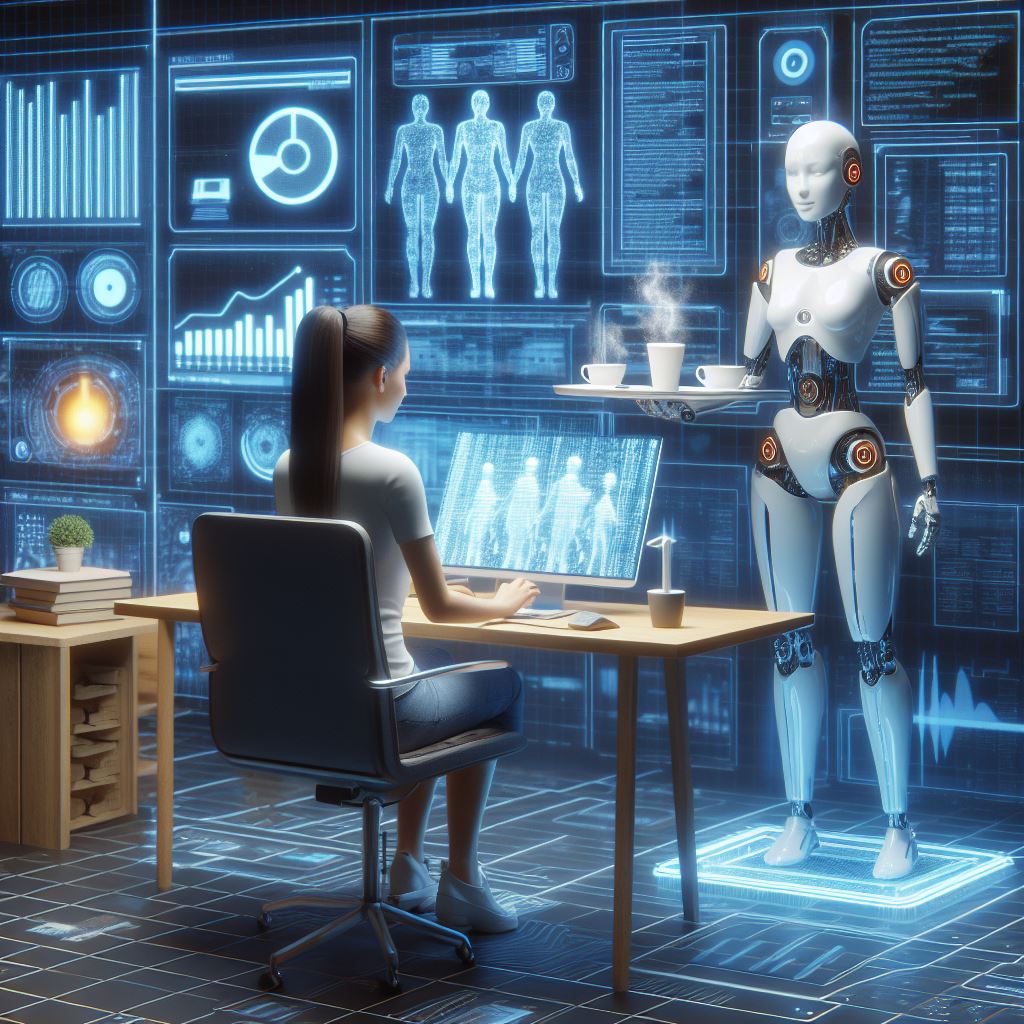Introduction
In this blog post, I’m going to explore how AI transforms work through automation and augmentation, and what it means for workers, employers, and society. Whether you’re a newbie or a pro, you’ll find something useful and interesting in this post. So, grab a cup of coffee and let’s get started!
You might have heard of AI as the technology that can do things that normally require human intelligence, such as thinking, learning, deciding, and perceiving. Sounds cool, right? Well, it is. But it also means that AI can do things that normally require human work, such as typing, calculating, serving, etc. Sounds scary, right? Well, it is. But it also means that AI can do things that can help human work, such as designing, researching, innovating, etc. Sounds awesome, right? Well, it is.
How AI automates work
AI can automate work by doing tasks that are boring, tedious, or predictable, such as data entry, accounting, customer service, etc. This means that AI can replace human labor with technology, and make work faster, easier, cheaper, and safer. This also means that human workers can focus on more valuable and meaningful tasks, and have more time and freedom.
But AI automation is not all sunshine and rainbows. It also has some drawbacks and challenges, such as:
- It can displace workers and create unemployment, especially for low-skilled and low-paid workers. This can lead to social and economic problems, such as poverty, inequality, and unrest.
- It can create skill gaps and require new skills and competencies, especially for high-skilled and high-paid workers. This can lead to education and training challenges, such as access, quality, and relevance.
- It can require new infrastructure and regulations, especially for legal and ethical issues. This can lead to governance and policy challenges, such as standards, accountability, and transparency.
AI automation is already transforming work in many sectors and domains, such as:
- Manufacturing: AI can automate the production and assembly of goods, such as cars, clothes, and electronics. This can increase the efficiency, quality, and safety of manufacturing, and reduce the costs, errors, and risks. For example, Tesla uses AI to automate the manufacturing of its electric vehicles, and improve its performance and innovation.
- Retail: AI can automate the sales and service of goods, such as groceries, books, and clothes. This can increase the convenience, personalization, and satisfaction of retail, and reduce the labor, inventory, and waste. For example, Amazon Go uses AI to automate the checkout process of its stores, and eliminate the need for cashiers and queues.
- Transportation: AI can automate the movement and delivery of goods and people, such as cars, trucks, and drones. This can increase the speed, reliability, and accessibility of transportation, and reduce the accidents, emissions, and congestion. For example, Uber uses AI to automate the matching and routing of its drivers and riders, and optimize its service and pricing.
These are just some of the examples of how AI automation is transforming work in different sectors and domains. There are many more, and you can always do your own research and observation to find out more about AI automation.
How AI augments work
AI can augment work by doing tasks that are complex, creative, or collaborative, such as design, research, innovation, etc. This means that AI can enhance human skills and capabilities with technology, and make work smarter, better, and more enjoyable. This also means that human workers can leverage AI as a tool and a partner, and create new possibilities and opportunities.
But AI augmentation is not all roses and chocolates. It also has some drawbacks and challenges, such as:
- It can require human oversight, adaptation, and trust, especially for quality and accuracy issues. This can lead to human and machine challenges, such as feedback, communication, and collaboration.
- It can create new responsibilities and expectations, especially for performance and satisfaction issues. This can lead to work and life challenges, such as stress, pressure, and balance.
- It can pose ethical and social issues, especially for values and interests issues. This can lead to moral and cultural challenges, such as fairness, diversity, and identity.
AI augmentation is already transforming work in many sectors and domains, such as:
- Healthcare: AI can augment the diagnosis and treatment of diseases, such as cancer, diabetes, and COVID-19. This can increase the accuracy, effectiveness, and accessibility of healthcare, and reduce the costs, errors, and risks. For example, IBM Watson uses AI to augment the decision making of doctors and nurses, and provide personalized and evidence-based recommendations.
- Education: AI can augment the learning and teaching of skills and knowledge, such as math, language, and coding. This can increase the engagement, personalization, and outcomes of education, and reduce the gaps, barriers, and biases. For example, Duolingo uses AI to augment the learning and teaching of languages, and provide adaptive and gamified lessons.
- Entertainment: AI can augment the creation and consumption of content and experiences, such as music, movies, and games. This can increase the diversity, quality, and enjoyment of entertainment, and reduce the limitations, constraints, and boredom. For example, Spotify uses AI to augment the creation and consumption of music, and provide customized and curated playlists.
These are just some of the examples of how AI augmentation is transforming work in different sectors and domains. There are many more, and you can always use your imagination and experimentation to find out more about AI augmentation.
Implications and recommendations for workers, employers, and society
AI Automation and transformation of work has many implications and recommendations for workers, employers, and society, such as:
- For workers: how to prepare for the changing nature and demand of work, how to acquire new skills and competencies, how to adapt to the new work culture and environment, how to leverage AI as a tool and a partner, etc. Some of the tips and tricks for workers are:
- Be curious and open-minded, and embrace the opportunities and challenges that AI brings to work. Don’t be afraid or resistant to change, but be proactive and flexible.
- Be lifelong and self-directed learners, and acquire new skills and competencies that are relevant and valuable for work. Don’t rely on formal or traditional education, but seek informal and alternative learning sources and methods.
- Be collaborative and cooperative, and adapt to the new work culture and environment that AI creates. Don’t work in isolation or competition, but work in teams and networks.
- Be smart and savvy, and leverage AI as a tool and a partner that can help you work better and smarter. Don’t see AI as a threat or a replacement, but see AI as a friend and a helper.
- For employers: how to manage the transition and integration of AI in the workplace, how to redesign work processes and roles, how to train and reskill workers, how to foster a culture of innovation and collaboration, etc. Some of the tips and tricks for employers are:
- For society: how to ensure the responsible and ethical use of AI, how to address the social and economic impacts of AI, how to promote inclusion and diversity, how to balance human and machine values and interests, etc. Some of the tips and tricks for society are:
- Be aware and informed, and ensure the responsible and ethical use of AI. Don’t be ignorant or indifferent to the potential and risks of AI, but be educated and vigilant.
- Be proactive and responsive, and address the social and economic impacts of AI. Don’t be passive or reactive to the problems and opportunities of AI, but be active and constructive.
- Be fair and equitable, and promote inclusion and diversity among AI and workers. Don’t be biased or discriminatory to AI or workers, but be respectful and appreciative.
- Be balanced and harmonious, and balance human and machine values and interests. Don’t be conflicted or antagonistic to AI or workers, but be cooperative and complementary.
- Be strategic and visionary, and manage the transition and integration of AI in the workplace. Don’t ignore or delay the adoption of AI, but plan and implement it carefully and wisely.
- Be innovative and adaptive, and redesign work processes and roles to suit the capabilities and needs of AI and workers. Don’t stick to old or outdated work models, but create new and better work models.
- Be supportive and responsible, and train and reskill workers to cope with the changes and challenges that AI brings to work. Don’t neglect or abandon workers, but invest and empower workers.
- Be inclusive and participatory, and foster a culture of innovation and collaboration among AI and workers. Don’t impose or dictate AI, but involve and engage AI and workers.

These are some of the implications and recommendations of AI transformation of work for workers, employers, and society. Of course, there are more, and you can always do your own research and action to find out more about AI transformation of work.
Conclusion
AI Automation transforming work through automation and augmentation, and creating value and opportunities for workers, employers, and society. It can automate work by performing tasks that are repetitive, routine, or rule-based, and augment work by performing tasks that are complex, creative, or collaborative. AI can also bring benefits and challenges, such as increasing efficiency and productivity, enhancing capabilities and performance, displacing workers and creating skill gaps, requiring new infrastructure and regulations, etc.


Amira Sierra
Thank you for your sharing. I am worried that I lack creative ideas. It is your article that makes me full of hope. Thank you. But, I have a question, can you help me?